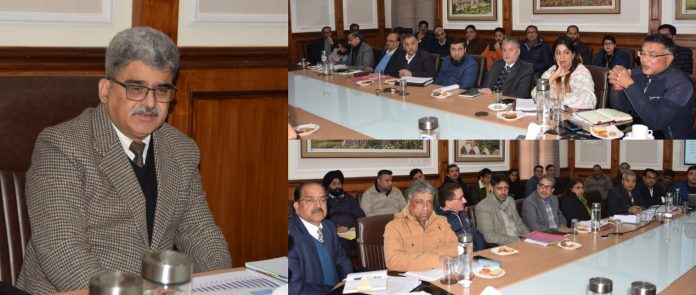- More than 5 lakh farmers under KisanSamparkAbhiyan&19000 youth contacted under YuvaVani reach out programs
JAMMU, Jan 16: Chief Secretary, Atal Dulloo today reviewed the major achievements and progress on the implementation of all the 29 projects and sub-projects of the Holistic Agriculture Development Program (HADP) here in the UT through different Project Grounding & Monitoring Committees (PGMCs) headed by senior officers of the UT administration.
Besides the Principal Secretary, Agriculture Production Department, the meeting was attended by the Vice Chancellors, SKUAST K/J; MD, HADP; Deputy Commissioners; Chairmen PGMCs; concerned HoDs; Bank representatives and other officers.
Outstation based officers participated in the meeting through video conferencing.
While reviewing the progress on the achievements made in implementation of this program the Chief Secretary emphasized upon prompt decision on the fate of applications received on the portal. He asked for moving ahead from the tendering and other modalities and focus on the establishment of different production units by the eligible beneficiaries.
He directed the two agricultural varsities to make short informational videos demonstrating the essential ingredients and processes of each agricultural activity for the awareness of farmers. He asked each Deputy Commissioner to generate awareness about the benefits of this program in their areas especially on the occasions of Block diwasheld across panchayats and attended by farmers in large numbers.
While speaking about this massive programDulloomade out that all the projects have been tailored out to bring maximum benefit to the farmers here. He observed that the projects are inclusive of different components for development of agriculture sector and many folds enhancement in the income of our farmers.
He advisedfor making the procedure for submission of applications simple, sticking purely to the guidelines delineated under the program. He asked for close monitoring of the progress by each PGMC chairperson in collaboration with the concerned Deputy Commissioner. He asked for meeting targets without fail as per the set timeline of this program.
The Principal Secretary, APD, Shailendra Kumar threw light on different parameters and achievements made by department in implementation of the sub-projects. He delineated the key steps taken by the department for the successful grounding of different projects of this mega program here.
He revealed that under the first phase of the ‘KisanSamparkAbhiyan’ conducted between 24th of April and 31st August last year around 5,10,000 farmers were covered across 3697 panchayats. Moreover under block level youth orientation programme more than 19000 youth were contacted to map their skillsets and interests in farming. He also made out that the rest of panchayats are being covered underphase 2nd to reach out to all the areas of the UT.
Regarding the implementation of the program it was given out that a number of steps had been taken for monitoring & evaluation of the projects, carrying ofoutreach activities, redrafting of loan guidelines, focussed attention on application processing, holistic skilling, coordination between multiple agencies implementing same projects besides making specific interventions for impactful farm mechanization and making eligibility conditions more realistic and practical in nature.
On the occasion the district wise ranking as per different parameters of the program was depicted which was said to be a regular feature to be updated each month. It was said that the ranking was done on the number of applications received, approvals given and the percentage of rejections from each district.
Further it was made out that till now 52693 applications have been received on the Kisan Sathi portal with registration of 50662 farmers. It was apprised that 43831 applications have been received in Agriculture sector, 1214 in horticulture and 14472 in Livestock production.
The meeting also discussed the project wise monitorable indicators, challenges faced in its swift implementation and the possible solutions available for its smooth implementation in the UT.


